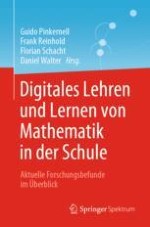2022 | OriginalPaper | Buchkapitel
2. Mathematiklehren und -lernen digital – Theorien, Modelle, Konzepte
verfasst von : Angelika Bikner-Ahsbahs
Erschienen in: Digitales Lehren und Lernen von Mathematik in der Schule
Verlag: Springer Berlin Heidelberg
Aktivieren Sie unsere intelligente Suche, um passende Fachinhalte oder Patente zu finden.
Wählen Sie Textabschnitte aus um mit Künstlicher Intelligenz passenden Patente zu finden. powered by
Markieren Sie Textabschnitte, um KI-gestützt weitere passende Inhalte zu finden. powered by
